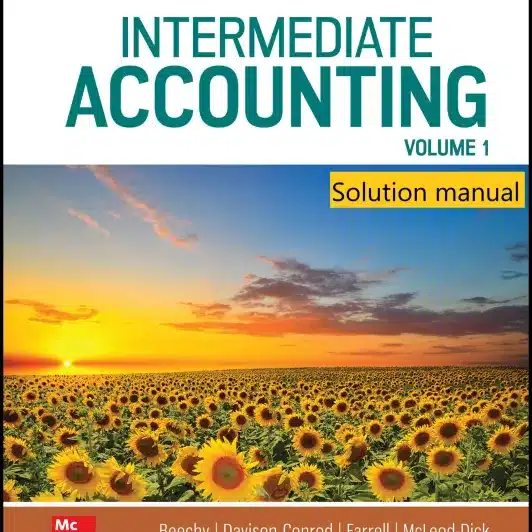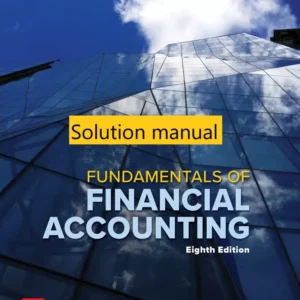Original price was: $39.990.$24.990Current price is: $24.990.
Solution manual for Intermediate Accounting Volume 1 9th Edition By Thomas H. Beechy © 2025
Product ID: 0917200
Immediate Purchase Link:
Downloadable link.
For Contact: [email protected]
Description
Solution Manual for Intermediate Accounting, Volume 1, 9th Edition by Thomas H. Beechy (© 2025)
Product Overview
The Solution Manual for Intermediate Accounting, Volume 1, 9th Edition by Thomas H. Beechy is an essential resource for students and instructors of intermediate accounting. This comprehensive guide offers step-by-step solutions to the exercises in the Intermediate Accounting textbook, simplifying complex accounting principles and providing a solid understanding of key financial reporting concepts.
Designed for both learning and teaching, the Solution Manual helps students build confidence by offering detailed explanations of accounting processes. It also helps instructors manage their courses effectively, providing the tools to assess student progress and ensure thorough comprehension of accounting topics.
Key Features of the 9th Edition
1. Comprehensive Coverage of Accounting Topics
This edition thoroughly covers fundamental intermediate accounting concepts, from financial reporting frameworks to financial instruments, ensuring that students gain a deep and well-rounded understanding of accounting. The manual includes solutions for complex topics such as revenue recognition, depreciation, and financial statement analysis.
2. Clear, Step-by-Step Solutions
Each chapter is designed to break down complex accounting problems into manageable steps, providing clear explanations and detailed solutions to help students fully grasp the material.
3. Real-World Application
The Solution Manual integrates real-world scenarios that help students see the relevance of accounting practices in business. This approach enhances students’ critical thinking skills and prepares them for practical challenges they may face in their professional careers.
4. Organized for Easy Reference
The manual is structured to allow for easy navigation and quick reference, with clearly marked chapters and topics. This helps students quickly find the information they need, making study sessions more efficient and focused.
Chapter Breakdown for Volume 1
Chapter 1: The Framework for Financial Reporting
-
Overview: This chapter introduces the framework of financial reporting, providing the essential foundation for understanding how financial statements are prepared and interpreted.
-
Key Concepts: Accounting standards, financial reporting objectives, and the conceptual framework.
Chapter 2: Accounting Judgements
-
Overview: Explores the judgment process in accounting, including how and when professional judgment is applied in financial reporting.
-
Key Concepts: Estimation techniques, recognition criteria, and judgmental areas in accounting.
Chapter 3: Statements of Income and Comprehensive Income
-
Overview: Discusses the preparation and analysis of income statements and comprehensive income, focusing on how businesses report profits and losses.
-
Key Concepts: Income statement formats, non-operating income, and comprehensive income.
Chapter 4: Statements of Financial Position and Changes in Equity; Disclosure Notes
-
Overview: This chapter covers the preparation of the balance sheet (statement of financial position) and the statement of changes in equity, as well as the importance of disclosure notes in financial reporting.
-
Key Concepts: Assets, liabilities, equity sections, and required disclosures.
Chapter 5: The Statement of Cash Flows
-
Overview: Explains the statement of cash flows, focusing on the classification of cash inflows and outflows into operating, investing, and financing activities.
-
Key Concepts: Direct vs. indirect method, operating activities, investing activities, and financing activities.
Chapter 6: Revenue Recognition
-
Overview: Provides an in-depth look at the principles and guidelines for recognizing revenue in financial statements.
-
Key Concepts: Revenue recognition criteria, performance obligations, and timing of recognition.
Chapter 7: Financial Assets: Cash and Receivables
-
Overview: This chapter focuses on the accounting treatment for financial assets, particularly cash and receivables, including recognition, measurement, and impairment.
-
Key Concepts: Cash equivalents, accounts receivable, bad debts, and allowance methods.
Chapter 8: Cost-Based Inventories and Cost of Sales
-
Overview: Discusses inventory valuation methods (such as FIFO, LIFO, and weighted average) and how these methods impact the cost of sales.
-
Key Concepts: Inventory valuation, cost of goods sold, and inventory write-downs.
Chapter 9: Long-Lived Assets
-
Overview: Explores the accounting for long-lived assets, including property, plant, and equipment, as well as intangible assets.
-
Key Concepts: Acquisition costs, useful life, asset impairment, and disposal of assets.
Chapter 10: Depreciation, Amortization, and Impairment
-
Overview: This chapter covers the methods and principles used for depreciating tangible assets, amortizing intangible assets, and recognizing impairments.
-
Key Concepts: Depreciation methods (straight-line, declining balance), amortization, and impairment testing.
Chapter 11: Financial Instruments: Investments in Bonds and Equity Securities
-
Overview: Explains the accounting for financial instruments, including investments in bonds and equity securities, covering valuation and reporting.
-
Key Concepts: Fair value vs. cost method, bond investments, and equity securities accounting.
Why Choose the Solution Manual for Intermediate Accounting Volume 1?
The Solution Manual for Intermediate Accounting, Volume 1 is an essential tool for both students and instructors. With detailed solutions, clear explanations, and real-world examples, this manual provides the foundation for mastering the complexities of intermediate accounting. Whether you’re preparing for exams or teaching accounting concepts, this solution manual ensures a comprehensive understanding of accounting principles and practices.
For additional test banks and manual solutions, click here.






Up-to-date
Detailed explanation
Explained in simple terms